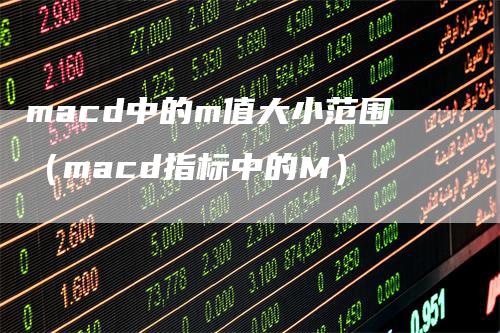
What is the range of the 'M' value in MACD?
The 'M' value in the Moving Average Convergence Divergence (MACD) indicator represents the number of periods used to calculate the shorter-term Exponential Moving Average (EMA). The 'M' value plays a crucial role in determining the sensitivity and responsiveness of the MACD indicator. Let's explore the range of the 'M' value and its impact on MACD's effectiveness.
Why is the 'M' value important?
The 'M' value determines the speed at which the MACD line reacts to changes in the price trend. A smaller 'M' value leads to a faster response, while a larger 'M' value results in a slower response. It is crucial to select an appropriate 'M' value that aligns with the time frame of the analysis and the desired level of sensitivity.
What is the range of the 'M' value?
The range of the 'M' value depends on the trading platform or charting software being used. Typically, the commonly available range for the 'M' value lies between 1 and 200. However, it is important to note that higher values of 'M' may not necessarily improve the accuracy of the MACD indicator.
How to choose the 'M' value?
Choosing the right 'M' value involves considering several factors. Firstly, it depends on the trader's preferred trading time frame. For shorter time frames, a smaller 'M' value, such as 12 or 26, is often used. For longer time frames, a higher 'M' value, such as 50 or 200, may be more appropriate.
Secondly, the choice of 'M' value depends on the market being analyzed. More volatile markets may require a smaller 'M' value for quicker responses, while less volatile markets may necessitate a larger 'M' value for smoother signals.
Lastly, it is important to consider the overall trading strategy and risk tolerance. Traders seeking more frequent signals may opt for smaller 'M' values, while those who prefer smoother and less frequent signals might choose higher 'M' values.
What are the implications of choosing an inappropriate 'M' value?
If the 'M' value is too small, the MACD line may generate too many signals, resulting in a higher number of false or premature trading opportunities. Conversely, if the 'M' value is too large, the MACD line may lag behind the price trend, causing delayed signals and missed trading opportunities.
Therefore, it is crucial to find the right balance and consider the specific market conditions and trading strategy when selecting the 'M' value. Regular monitoring and adjustments may be necessary to ensure the effectiveness of the MACD indicator.
Conclusion
The 'M' value in MACD is an important parameter that determines the speed and sensitivity of the indicator. It should be chosen carefully based on the trading time frame, market conditions, and personal trading strategy. Finding the appropriate 'M' value can greatly enhance the accuracy of the MACD indicator and improve trading decisions.
